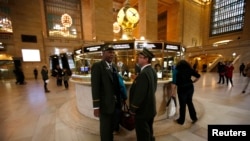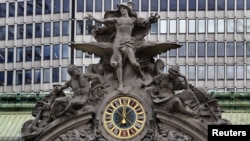NEW YORK —
Grand Central Terminal - usually called Grand Central Station - is 100 years old this month, a living symbol of New York City. A year-long celebration is planned for the Beaux-Arts landmark - "beloved, glowing, indispensable," as a new book describes it - that is also one of the world’s most visited tourist destinations.
Visitors marveled at the ornate limestone building when Grand Central opened on February 2, 1913. They still do. It is the largest train station in the world, by the number of platforms: 44, serving 67 tracks, all underground. About 750,000 people pass through its halls each day, whether to shop, sightsee, or catch a subway or commuter train.
The immense main concourse, with its arched windows, jewel-like four-sided clock and old-fashioned ticket-seller windows has appeared in many movies, as well, from the 1950s thriller North by Northwest, to a scene in the 1995 The Fisher King, where weary commuters crossing the marble floor are briefly transformed into waltzing couples.
"Grand Central is the kind of temple, cathedral that testifies to the magnificence of rail transportation, the kind that God would have built if he’d had the money," says Dan Brucker, a transit authority docent who has worked at the terminal for three decades. "But He didn’t. The Vanderbilts did," he adds, referring to the family whose fortune, derived from sea and rail transportation, built the station.
Stars shine down on commuters
"Look at how beautiful it is," he says. "This is the beginning of 20th-century architecture. And as people come through this terminal, they don’t even realize that the magnificent celestial ceiling above them, the very roof of heaven, is exactly wrong, is exactly opposite: It’s a mirror image."
It is true: the turquoise October sky painted on Grand Central’s cylindrical ceiling, with pinpricks of light for stars, reverses the Zodiac, whether through the painter’s error or choice. "Some suggest the stars are the firmament as God would see the heavens from His or Her side of the firmament, and I sort of like that version," says urban historian Justin Ferate, who has been giving tours of Grand Central for 30 years.
Ferate says the station was designed to make travel pleasurable: a journey, not a slog. "The amazing thing about Grand Central is that it processes many, many more people than most airports in the world, in a way that’s gracious, and friendly," he says. "Looking up at the starry sky of Grand Central, you know you’re a traveler, you’re going off on a great adventure, you’re going to follow your stars and find your dream. You’re also going to find your train where it’s supposed to be."
Each architectural element was sized with human perception and anatomy in mind, Ferate adds, from the steps to the blocks in the Tennessee marble floors. He demonstrates by walking backwards down the concourse steps, taking off on a looping run through the crowd, and then sitting down on the floor.
"One of the amazing things about why people don’t run into each other in Grand Central is something very simple," he says. "Each block of stone in Grand Central is the length of your leg. Each block of stone is a different color, so it’s a checkerboard, based on you. So, when you run across the floor, you subliminally know exactly where everyone is standing."
History and mystery
The terminal is full of secrets and rooms that few people ever see. Deep underground, on a disused track that runs a few blocks to a space beneath the Waldorf-Astoria Hotel, sits a rusting railway car. It was used by former president Franklin D. Roosevelt, who hid the fact of his paralysis from public view by transferring directly from the train to a private automobile on his visits to New York.
In the Grand Central Oyster Bar, a restaurant that’s been part of the terminal from the beginning, an acoustical anomaly means that private conversations don’t always remain private: the tiled ceiling makes even whispers at some tables audible on the other side of the room. The whispering gallery, which has the same tiled ceiling, is a favorite stage for marriage proposals, according to Ferate.
Little-remembered now is that Grand Central Terminal was the target of a Nazi plot during WWII: Two German agents were dispatched to sabotage the giant rotary convertors in a deep subbasement that supplied electrical current for the railways. The two were found out and arrested before they reached New York. In 1976, a group of Croatian nationalists planted a bomb in a locker at the station, hijacked a plane, and issued a set of demands. The New York Police Department’s attempt to disarm the bomb according to their instructions went awry, however. Thirty people were wounded and an NYPD bomb squad member killed when the bomb exploded.
View to impress
One of Justin Ferate’s favorite aspects of Grand Central is its exterior: not only the statue of the Roman god Mercury standing atop the Tiffany clock on the facade - flanked by statues of Minerva and Hercules - but the raised road and tunnel that shunt traffic around the terminal. "As you go through the tunnel, you’ll see daylight at the end of the tunnel and then you’ll rise high above the city," he explains, "And you’ll have buildings on the right and left that are holding you, just like a roller coaster ride at Coney Island!"
Grand Central narrowly escaped destruction when plans for topping it with an office tower were unveiled in 1968. The 10-year battle to save the terminal helped create the modern architectural preservation movement around the U.S. Now, no one would think of tampering with its classic beauty. In fact, in 2019, Grand Central will become even larger, adding a new subterranean station serving the Long Island Railroad, and cutting the travel times of thousands of commuters. The escalator ride down to what Dan Brucker says will be the deepest station on earth will take two and a half minutes.
Visitors marveled at the ornate limestone building when Grand Central opened on February 2, 1913. They still do. It is the largest train station in the world, by the number of platforms: 44, serving 67 tracks, all underground. About 750,000 people pass through its halls each day, whether to shop, sightsee, or catch a subway or commuter train.
The immense main concourse, with its arched windows, jewel-like four-sided clock and old-fashioned ticket-seller windows has appeared in many movies, as well, from the 1950s thriller North by Northwest, to a scene in the 1995 The Fisher King, where weary commuters crossing the marble floor are briefly transformed into waltzing couples.
"Grand Central is the kind of temple, cathedral that testifies to the magnificence of rail transportation, the kind that God would have built if he’d had the money," says Dan Brucker, a transit authority docent who has worked at the terminal for three decades. "But He didn’t. The Vanderbilts did," he adds, referring to the family whose fortune, derived from sea and rail transportation, built the station.
Stars shine down on commuters
"Look at how beautiful it is," he says. "This is the beginning of 20th-century architecture. And as people come through this terminal, they don’t even realize that the magnificent celestial ceiling above them, the very roof of heaven, is exactly wrong, is exactly opposite: It’s a mirror image."
It is true: the turquoise October sky painted on Grand Central’s cylindrical ceiling, with pinpricks of light for stars, reverses the Zodiac, whether through the painter’s error or choice. "Some suggest the stars are the firmament as God would see the heavens from His or Her side of the firmament, and I sort of like that version," says urban historian Justin Ferate, who has been giving tours of Grand Central for 30 years.
Ferate says the station was designed to make travel pleasurable: a journey, not a slog. "The amazing thing about Grand Central is that it processes many, many more people than most airports in the world, in a way that’s gracious, and friendly," he says. "Looking up at the starry sky of Grand Central, you know you’re a traveler, you’re going off on a great adventure, you’re going to follow your stars and find your dream. You’re also going to find your train where it’s supposed to be."
Each architectural element was sized with human perception and anatomy in mind, Ferate adds, from the steps to the blocks in the Tennessee marble floors. He demonstrates by walking backwards down the concourse steps, taking off on a looping run through the crowd, and then sitting down on the floor.
"One of the amazing things about why people don’t run into each other in Grand Central is something very simple," he says. "Each block of stone in Grand Central is the length of your leg. Each block of stone is a different color, so it’s a checkerboard, based on you. So, when you run across the floor, you subliminally know exactly where everyone is standing."
History and mystery
The terminal is full of secrets and rooms that few people ever see. Deep underground, on a disused track that runs a few blocks to a space beneath the Waldorf-Astoria Hotel, sits a rusting railway car. It was used by former president Franklin D. Roosevelt, who hid the fact of his paralysis from public view by transferring directly from the train to a private automobile on his visits to New York.
In the Grand Central Oyster Bar, a restaurant that’s been part of the terminal from the beginning, an acoustical anomaly means that private conversations don’t always remain private: the tiled ceiling makes even whispers at some tables audible on the other side of the room. The whispering gallery, which has the same tiled ceiling, is a favorite stage for marriage proposals, according to Ferate.
Little-remembered now is that Grand Central Terminal was the target of a Nazi plot during WWII: Two German agents were dispatched to sabotage the giant rotary convertors in a deep subbasement that supplied electrical current for the railways. The two were found out and arrested before they reached New York. In 1976, a group of Croatian nationalists planted a bomb in a locker at the station, hijacked a plane, and issued a set of demands. The New York Police Department’s attempt to disarm the bomb according to their instructions went awry, however. Thirty people were wounded and an NYPD bomb squad member killed when the bomb exploded.
View to impress
One of Justin Ferate’s favorite aspects of Grand Central is its exterior: not only the statue of the Roman god Mercury standing atop the Tiffany clock on the facade - flanked by statues of Minerva and Hercules - but the raised road and tunnel that shunt traffic around the terminal. "As you go through the tunnel, you’ll see daylight at the end of the tunnel and then you’ll rise high above the city," he explains, "And you’ll have buildings on the right and left that are holding you, just like a roller coaster ride at Coney Island!"
Grand Central narrowly escaped destruction when plans for topping it with an office tower were unveiled in 1968. The 10-year battle to save the terminal helped create the modern architectural preservation movement around the U.S. Now, no one would think of tampering with its classic beauty. In fact, in 2019, Grand Central will become even larger, adding a new subterranean station serving the Long Island Railroad, and cutting the travel times of thousands of commuters. The escalator ride down to what Dan Brucker says will be the deepest station on earth will take two and a half minutes.










